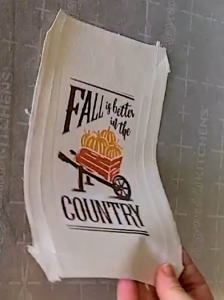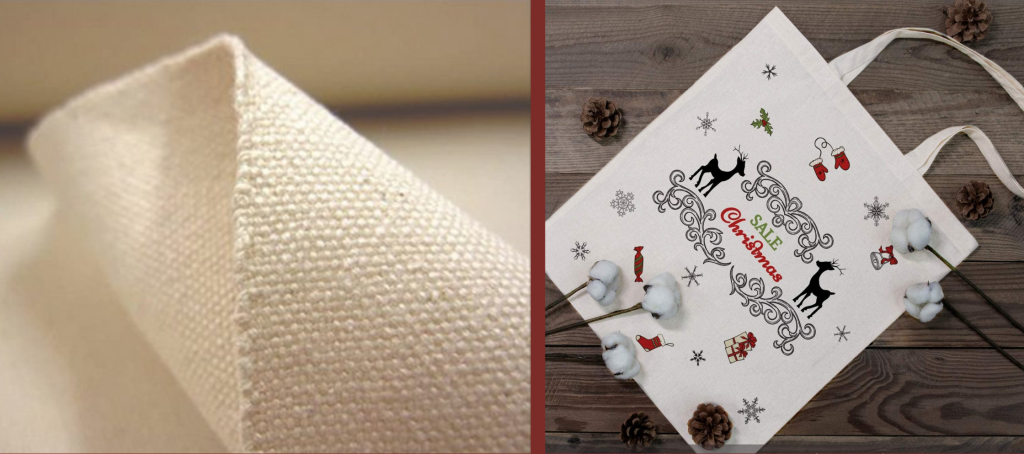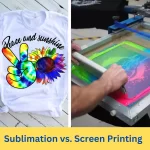Art lovers often ask the question “Can you sublimate on canvas”? The answer is YES, it is possible to sublimate on canvas material! With the rise in the popularity of photo art, many people are looking for innovative methods to create their own special designs using their digital images.
I’ve been a fan of canvas prints, but I was always disappointed that I couldn’t find any that were personalized. So, I decided to learn to sublimate on canvas myself. I was skeptical at first, but I decided to give it a try, and were amazed at how easy it was.
Here, I’m going to share my personal experience with sublimation on canvas. I’ll cover everything you need to know, from choosing the right canvas to preparing your design to pressing it.
Note: here are the tips to make your sublimation brighter and more vibrant.
Contents
Canvas Sublimation
Canvas sublimation is a process that transfers digital prints onto a blank canvas sheet using heat and pressure. The process is truly fascinating and produces vibrant, high-quality prints with exceptional detail and color accuracy.
I have seen how canvas sublimation breathes life into digital artwork and photographs, transforming them into stunning pieces of art. The colors are rich and vibrant, with a wide range of tones and shades that capture the smallest nuances and details.
No doubt canvas is a great material to print on as it can be cut in so many different sizes and shapes. Most people use them for home décor items such as canvas wall art and gallery wrap.
However, the popularity of canvas has led to different variations in the material. Canvas blanks are especially designed canvases to do photo sublimation. The two most popular fabrics of canvas are polyester and cotton.
One of the things that amazed me about canvas sublimation is its durability. The prints are resistant to fading, scratches, and moisture, ensuring that they can withstand the test of time. This makes them ideal for both indoor and outdoor display, whether it’s in a home, office, or even an art gallery.
How to Prepare Canvas for Sublimation?
After sublimated a few canvases, I have found that the most important step is to prepare the canvas properly. If the canvas is not prepared correctly, the sublimation ink will not transfer properly, and the image or design will not be as clear or as vibrant.
Here are the steps I follow to prepare canvas for sublimation:
1. Clean the canvas: The canvas should be clean and free of dust or dirt. I use a mild soap and water solution to clean the canvas. Use a lint-free cloth to gently clean the surface, ensuring there are no particles that could affect the printing process or the final result.
2. Check the canvas for coating: Some canvases are already coated with a sublimation-friendly material. If the canvas is not coated, you will need to coat it yourself. I use a sublimation coating spray to coat my canvases.
3. Pre-press the canvas: Pre-pressing helps remove any moisture or wrinkles from the canvas, ensuring a smooth surface for sublimation. Place the canvas on the heat press and apply light pressure for around 10-15 seconds at a temperature of around 300°F (150°C).
4. Trim the edges: Use a sharp pair of scissors or a cutting tool to trim any excess or uneven edges of the canvas.
After the canvas has been pressed, the sublimation ink will have transferred to the canvas. The image or design should be clear and vibrant.
How to Sublimate on Canvas

In a nutshell, the image or design is printed onto special sublimation paper, which is then placed face down on the canvas. A heat press is then used to apply heat and pressure to the paper and canvas, which turns ink into a gas. The gas then penetrates the surface of the canvas, leaving behind a permanent, high-quality image.
It may sound easy but there are a few complications involved, and to overcome those, I’ve explained step by step guides to sublimate on canvas materials.
Things Required:
- Sublimation printer
- Special sublimation ink
- Sublimation paper
- Sublimation-ready canvas blank (preferably polyester)
- Heat press
- Heat resistant tape
- Scissor
- Non-stick paper or Teflon sheet
This sublimation process is best suited for all types of canvas blanks including frames, boards, panels, canvas tote bags, and canvas shoes, etc.
Step 1: Prepare Your Artwork
Create or select the artwork or photograph you want to sublimate onto the canvas. Ensure it is of high resolution and suitable for printing.
Step 2: Set Up the Printer
Install the sublimation ink cartridges into your sublimation printer and adjust the printer settings to the following:
- Color Mode: CMYK
- Resolution: High quality (300 DPI or higher)
- Paper Type: Sublimation paper
- Ink Type: Sublimation Ink
- Print orientation: Mirrored
Step 3: Print onto Sublimation Paper
Load the sublimation transfer paper into the printer tray and print your artwork onto it. Remember to mirror the image horizontally to achieve the correct orientation on the canvas.
Step 4: Preheat the Heat Press
Turn on the heat press machine and set it to the temperature at 390-405 degrees Fahrenheit, and pressure at 30-35 psi for sublimation printing on canvas. Preheat the press for approximately 5 minutes to ensure consistent heat distribution.
Step 5: Prepare the Canvas
Once the heat press machine is heated, place the coated canvas on the heat press plate, ensuring it is flat and free from any wrinkles or creases.
Step 6: Secure the Sublimation Paper
Position the printed sublimation paper with the image facing down onto the canvas blank. Use heat-resistant tape to secure the paper onto the canvas, ensuring it remains in place during the transfer process.
Step 7: Transfer the Image

- Temperature: 390°F (199°C)
- Time: 60 seconds
The heat and pressure will cause the sublimation ink on the paper to turn into a gas and penetrate the canvas fibers.
Step 8: Remove the Paper and Tape
Once the transfer time is complete, carefully open the heat press and remove the heat-resistant tape and sublimation paper. Be cautious as the canvas and heat press platen will be hot.
I always wear heat resistant gloves while sublimation, and I’ll recommend the same to protect your hands from any accidental burning.
Step 9: Cooling and Finishing
Allow the canvas to cool down completely. This helps the sublimated ink to set properly. Once cooled, you can trim any excess paper or threads and inspect the print for quality.
Video tutorial on how to do sublimation on polyester canvas
How to Sublimate on Cotton Canvas
Cotton canvas is not suitable for sublimation printing due to its natural fiber composition. Cotton, being a natural fiber, lacks the receptive coating, preventing the ink from properly bonding to the fabric.
As a result, sublimation on cotton canvas will not produce vibrant colors or achieve the same level of detail and longevity as it would on polyester-coated canvas. Therefore, it is recommended to use polyester-coated or specifically designed sublimation canvas for optimal results in sublimation printing.
If you decide to proceed with sublimation on cotton canvas, one additional step you can take is to apply a polyester coating or sublimation coating spray to the cotton fabric. The purpose of this coating is to create a surface that is more receptive to sublimation inks and enhances the transfer process.
Here’s a general guideline for applying a polyester coating to cotton canvas and canvas blanks without lamination:
1. Prepare the cotton canvas: Ensure that the cotton canvas is clean, and free from any dust, dirt, or sizing agents that may interfere with the coating. Wash and dry the fabric if necessary.
2. Choose a polyester coating: Look for a polyester-based coating that is specifically designed for sublimation on cotton. These products can often be found from specialty sublimation suppliers.
3. Apply the coating: Typically, it involves spraying or brushing the coating onto the cotton canvas in a thin and even layer. Take care to cover the entire surface of the fabric.
4. Allow drying time: After applying the coating, let the canvas dry completely. The drying time will vary depending on the specific product used.
5. Sublimate as usual: Once the coated cotton canvas is dry, you can proceed with the sublimation printing process mentioned above for polyester materials.
This typically involves printing your design onto sublimation transfer paper, placing it on the coated canvas, and applying heat and pressure using a heat press machine.
Note: You can also use sublimation coating spray for cotton instead of a thermal lamination sheet.
Video tutorial on how to do sublimation on cotton
How Long to Sublimate on Canvas?
I have sublimated a few canvases, and I have found that the time it takes to sublimate on canvas varies depending on a few factors, such as the type of canvas, the thickness of the canvas, and the heat press settings. However, in general, it takes about 50 to 60 seconds to sublimate on canvas.
During my sublimation projects on canvas material, I typically start with a time setting of around 60 seconds. I then closely monitor the process, observing how the ink reacts and penetrates the surface of the canvas.
If needed, I adjust the time slightly, adding or subtracting a few seconds, to ensure that the colors are vibrant and the image is well-transferred.
Wrapping Up
Yes, it’s possible to sublimate on canvas material and indeed it opens up exciting opportunities for creating vibrant and durable prints.
By using canvas sublimation, you can easily transfer a digital photo to a stretched canvas with the highest quality. You can customize stunning frames, tote bags, shoes, and other canvas blanks. The end result is an eye-catching artwork that can be used as wall art, a gift, or whatever your heart desires.
Whether you are using cotton or polyester canvases, the process is fairly simple and straightforward. Just make sure to follow the steps carefully, and you’ll be able to create beautiful pieces of art in no time!
Epson sublimation printers are taking the designing industry to an advanced level.
Frequently Asked Questions
How do you sublimate on canvas?
Follow this method to sublimate on canvas;
- Print the image or design you would like to sublimate onto the paper using a sublimation printer in an inverted format.
- Preheat your heat press to 380 degrees
- Cut the image out using scissors to the shape of the canvas.
- Place the design face down on the canvas and use heat press tape to secure it in place.
- Cover the design with a piece of paper and apply pressure and heat (380 to 400 degrees) using a heat press for about 45-50 seconds.
- Remove the paper and let the canvas cool down. Once it has cooled down, you can remove the heat press tape and display your work of art!
What type of canvas is used for sublimation?
Cotton and polyester canvases can both be used for sublimation. However, it is important to note that cotton canvases require lamination with thermal lamination paper prior to sublimation, while polyester canvases do not.
Can I sublimate on canvas tote?
Yes, you can sublimate on canvas tote bags using the same method described above. Just make sure to use a cotton canvas tote bag, as polyester tote bags are not suitable for sublimation.
Can you sublimate on 100 cotton canvas?
Yes, you can sublimate on 100% cotton canvas using the same method described above. However, it is important to note that cotton canvases require lamination with thermal lamination paper prior to sublimation.
- 5 Best 13×19 Sublimation Printer for Wide Format Substrates - December 27, 2023
- Best 11×17 Sublimation Printer to Print Tabloid Size Paper - December 26, 2023
- Epson ET-8550 vs ET-15000: Best Wide-Format EcoTank Printer - December 25, 2023








![Sublimation on Leather Products [Guide for Best Results] can you sublimate on leather](https://subliprinting.com/wp-content/uploads/2023/07/can-you-sublimate-on-leather-150x150.webp)
